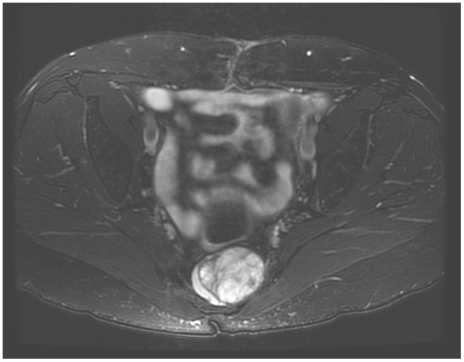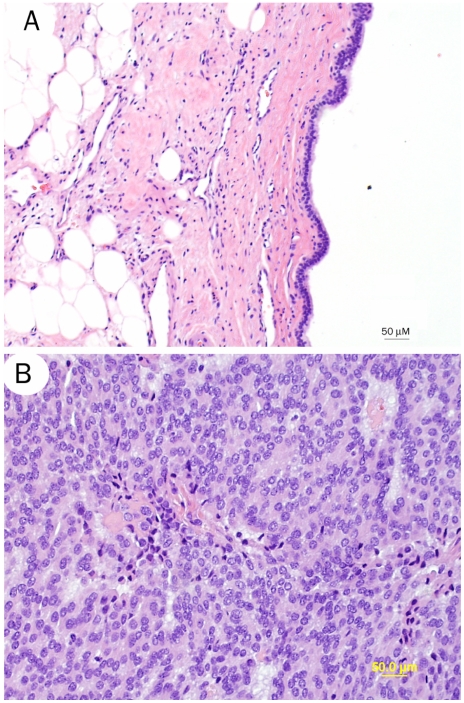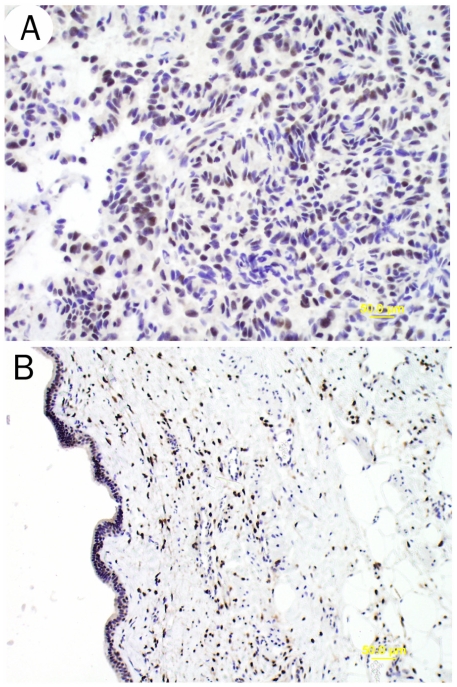Abstract
Tailgut cysts are uncommon developmental cysts that form in the presacral space. Complications of tailgut cysts include benign reactive lesions associated with infection and inflammation, and malignant transformation. Six cases of carcinoid tumor arising in tailgut cysts have been reported in the medical literature to date. Here we report another case of carcinoid tumor arising in a tailgut cyst. Because six of seven cases occurred in females, we postulate that these tumors are hormone-associated. This hypothesis is supported by the present study. We found strong estrogen receptor immunoreactivity of the benign squamous and columnar cyst-lining cells as well as carcinoid tumor cells, in addition to neuroendocrine differentiation in the tumor cells and scattered cyst-lining cells. We speculate that estrogen receptor may be a potential therapeutic target in patients with this condition.
Keywords: Carcinoid tumor, tailgut cyst, estrogen receptor
Introduction
Tailgut cysts, also known as retrorectal cyst hamartomas, are developmental cysts that form in the presacral space, which is bounded anteriorly by the rectum, posteriorly by the sacrum, superiorly by the peritoneal reflection, inferiorly by the coccygeus and levator ani muscles, and laterally by the ureter and iliac vessels [1, 2]. Although the origin of tailgut cysts is unknown, they are generally believed to arise from remnants of the embryonic hindgut. Complications of tailgut cysts include infection, inflammation, recurrent perianal fistulae, and malignant transformation. Adenocarcinoma and carcinoid tumor are the two most common malignancies reported [2].
Only six cases of carcinoid tumors arising in tailgut cysts have been reported in the medical literature to date [2–6]. Here we report an additional such case. This case is unique in that the benign cyst-lining epithelial cells and tumor cells were strongly positive for estrogen receptor (ER). Neuroendocrine differentiation was evident in the cyst-lining cells as well as the tumor cells. On the basis of these findings, we suggest that carcinoid tumor arising in tailgut cysts may be hormone-associated. Specifically, estrogen may play an important pathogenetic role. We further speculate that estrogen receptor may be a useful therapeutic target in patients with this condition.
Case Report
Clinical Findings
A 51-year-old African-American woman with a 3-year history of left hip pain was evaluated by her local physician for a possible left hip replacement.
The patient had a medical history of peripheral vascular disease and a surgical history of hysterectomy for uterine leiomyoma. She denied any history of alcohol or tobacco use. She was employed in a saw mill and has four children. There is no known family history of cancer. In November 2006, she underwent computerized tomography, which revealed a mass in the presacral space. Magnetic resonance imaging (MRI) of the pelvis showed a marginated soft tissue tumor, measuring 5 × 4.9 × 4.2 cm. A fat plane was present between the tumor and the rectum, and the latter was pushed anteriorly. The imaging results suggested a tumor of neurogenic origin (Figure 1). Subsequently, a needle biopsy was performed, which revealed atypical oval to round cells suggestive of a Mullerian carcinoma versus mesothelioma. Exploratory laparotomy performed at an outside facility showed a mass, deemed unresectable, affixed to the sacrum and intimately involved with the presacral vessels.
Figure 1.
Sagittal section MRI of the lower abdomen and pelvis revealed a marginated soft tissue tumor in the presacral space. Of note, the tumor mass, located posterior to the rectum and anterior to the sacrum and coccyx, was closely juxtaposed to the bone but does not appear to directly involve the bone.
In February, 2007, the patient was referred to our cancer center for further evaluation. CT and MRI showed that the mass was stable, with no change in size or shape compared with previous images. No contiguous osseous tissue was found. The patient underwent a thorough staging evaluation, including colonoscopy and imaging of all organ systems, with no evidence of primary or metastatic disease found. Pelvic washings revealed only reactive mesothelial cells. After a diagnosis of neuroendocrine carcinoma was made by a repeat core biopsy, re-exploration and resection of the mass were performed. Preoperative serum metanephrine levels were within normal range. The mass was dissected along the fibrous attachments in a circumferential fashion. The patient was discharged on oral antibiotics.
Pathological Findings
By gross examination, the excised mass measured 4.6 × 4.1 × 3.9 cm and was predominantly composed of solid soft tissue, with a cut surface showing slightly lobulated tan and pink tissue without hemorrhage or necrosis and a cystic space, comprising approximately 20% of the specimen, that was filled with thick gray flaky material. The entire mass was examined histologically.
Microscopic examination revealed multiple cysts of various sizes lined by benign stratified squamous and mucinous columnar epithelium with focal xanthogranulomatous inflammation (Figure 2A). The surrounding solid mass was composed of relatively uniform oval-to-round cells that exhibited fine chromatin and were arranged in solid, trabecular, or rosette-like growth patterns (Figure 2B). No tumor necrosis, nuclear atypia, or increased mitotic activity was identified. No skin adnexal structures, neuronal elements, or heterologous mesenchymal tissues such as bone or cartilage were identified. Immunohisto-chemical analysis of the mass was performed; characteristics of the antibodies used are summarized in Table 1. The neoplastic cells, stromal cells, and squamous and columnar lining cells were strongly positive for ER (Figure 3), and weakly focally positive for progesterone receptor (PR) (data not shown). The tumor cells were diffusely positive for synaptophysin, chromogranin, and pancytokeratin, confirming the neuroendocrine nature of the carcinoid tumor (data not shown). In addition, neuroendocrine cells were also identified in the columnar epithelium-lined cysts. Tumor cells had a low proliferation index (Ki-67>1%).
Figure 2.
Small cysts are lined by benign squamous and columnar epithelium with focal xantho-granulomatous inflammation (A). The solid component of the mass was composed of relatively uniform oval or round cells with fine chromatin, arranged in solid, trabecular or rosette-like growth pattern, with no tumor necrosis, nuclear atypia or increased mitosis (B).
Table 1.
Immunohistochemical profiles
| Antibody | Manufacture | Clone | Dilution | Antigen retrieval | Tumor cells | Cyst-lining cells |
|---|---|---|---|---|---|---|
| Synaptophysin | Dako, CA | Sy38 | 1:200 | Citrate | +++ | ++ |
| Chromagranin | Chemicon, CA | LK2H10 | 1:4000 | Citrate | ++ | ++ |
| ER | Novacastra, MA | ER6F11 | 1:50 | Tris | ++ | ++ |
| PR | Neomarkers, CA | 1AR | 1:200 | Citrate | + | + |
| Pankeratin | * | * | * | * | +++ | +++ |
| CAM5.2 | BD Bioscience | Cam5.2 | 1:50 | P24 | +++ | +++ |
| GFAP | BD Bioscience | Polyclonal | 1:6000 | Citrate | − | − |
| Inhibin | Oxford Biochem, UK | RI | 1:50 | Citrate | − | − |
| Ki-67 | Dako, CA | MiB1 | 1:100 | Citrate | + | + |
| CDX2 | Biogenex, CA | CDX2-88 | 1:50 | Tris-EDTA | − | − |
| S100 | Biogenex, CA | A6 | 1:40 | No retrieval | − | − |
Keratin cocktail: AE1/AE3, DAKO, CA, 1:500; CAM5.2, Becton Dickinson, CA, 1:50; Cytokeratin MNF116, DAKO, CA, 1:50 and Keratin 8/18, Zymed, CA, 1:25
Figure 3.
The tumor cells (A) and benign columnar-lining and stromal cells (B) are diffusedly positive for ER.
Discussion
Tailgut cysts occur in all age groups and are three times more common in women than in men. Nearly half of patients are asymptomatic, and the other half present with symptoms of mass effect or pain. The cysts may be unilocular or multilocular, and may be filled with clear-to-straw-colored thin, watery fluid or thick, mucoid fluid. They range in size from 2 to 12 cm in their largest dimension, and are soft, well-circumscribed lesions that are entirely limited to the presacral space. Various epithelial linings may be seen, including stratified squamous, cuboidal, transitional, stratified columnar, mucinous, or ciliated columnar. Interrupted bundles and wisps of smooth muscle are present, separated from the epithelium by a thin layer of fibrous tissue; however, there is no distinct nerve plexus [1, 2]. Inflammation, including xanthogranulo-matous type, is present in approximately half of cases.
Six carcinoid tumors arising in tailgut cysts have been previously reported. In five of the six, the tumors were located within the presacral space, while in one case, the tumor was at the anorectal junction [3]. The clinicopathologic features of all reported cases of carcinoid tumor arising in a tailgut cyst are summarized in Table 2. Of note, six of seven patients were women, which prompted us to consider the possibility of a hormone association. As illustrated in Figure 3, the benign squamous and columnar lining, stromal and tumor cells in the present case were strongly positive for ER. Expression of ER in carcinoid tumor is unusual [4]. Furthermore, neuroendocrine markers were expressed not only by the carcinoid tumor, but also by the cystic columnar epithelium. These findings support our hypothesis that hormones, and in particular estrogen, may play an important role in the pathogenesis of this condition.
Table 2.
Reported cases of carcinoid tumor arising in tailgut cysts
| Case# | Age/Sex | Tumor size (cm) | Main symptoms | Follow-up | References |
|---|---|---|---|---|---|
| 1 | NA | NA | Constipation | NA | Song et al, 2004 [6] |
| 2 | 50/F | NA | Constipation | NA | Song et al, 2004 [6] |
| 3 | 18/F | 10 | Perianal pain | NA | Lin et al, 1992 [3] |
| 4 | 19/F | 8 | Pelvic pain | ANED, 4Y | Horestein et al, 1998 [4] |
| 5 | 69/F | 4 | Rectal pain/bleeding | ANED, 2Y | Prasad et al, 2000 [2] |
| 6 | 41/F | 2 | Perianal pain | DM*, 1Y3M | Song et al, 2004 [6] |
| 7 | 51/F | 4.6 | Left hip pain | ANED | Current report |
NA: no information available; ANED: alive with no evidence of disease; DM: distant metastasis (*by images only, no histologic diagnosis); Y, years; M, months; F, female
In all but one reported case, the disease was local, and in all cases for which follow-up data are available, patients have experienced a favorable clinical course (Table 2). These findings may reflect a low proliferative index (less than 1% of tumor cells displayed Ki-67 expression), as was documented in our case. Of interest, the only reported metastatic carcinoid tumor arising from a tailgut cyst was located in the breast [5] with no involvement of the most common sites of metastatic carcinoid tumor, which are the lung and liver. However, no additional analysis was performed to rule out the possibility of synchronous/metachronous tumors involving the presacral soft tissue and breast.
The differential diagnosis of carcinoid tumor arising in a tailgut cyst includes direct extension of colorectal carcinoid tumor into a preexisting tailgut cyst, metastasis from a systemic organ, and carcinoid tumor arising in a cystic teratoma. In the present case, endoscopic and imaging studies did not reveal evidence of a tumor in the rectosigmoid mucosa region, and no lesions were found in other organs. Presacral teratoma was excluded because no derivatives of the three germ cell layers (e.g., skin appendages, neuronal elements, heterologous mesenchymal tissue such as smooth muscle, cartilage, and bone) were found.
In summary, we report the seventh case of a carcinoid tumor arising in a tailgut cyst. We have demonstrated that the benign epithelial cyst-lining cells and the tumor cells are strongly immunoreactive for ER, and have documented neuroendocrine differentiation in cyst-lining cells. On the basis of these findings, we hypothesize that carcinoid tumor of tailgut cyst origin may be a hormone-associated phenomenon. Specifically, we postulate that estrogen may play an important role in pathogenesis. We further speculate that estrogen receptor may be a useful therapeutic target in patients with this condition. Further study with more cases and detailed clinical follow up is needed to validate our hypothesis.
Acknowledgments
We thank Dr. Jae Ro, MD, PhD, for his critical review of the manuscript and Ann Putton for her professional editing.
References
- 1.Hjermstad BM, Helwig EB. Tailgut cysts, report of 53 cases. Am J Clin Pathol. 1988;89:139–147. doi: 10.1093/ajcp/89.2.139. [DOI] [PubMed] [Google Scholar]
- 2.Prasad AR, Amin MB, Randolph TL, Lee CS, Ma CK. Retrorectal cystic hamartoma: report of 5 cases with malignancy arising in 2. Arch Pathol Lab Med. 2000;124:725–729. doi: 10.5858/2000-124-0725-RCH. [DOI] [PubMed] [Google Scholar]
- 3.Lin SL, Yang AH, Liu HC. Tailgut cyst with carcinoid: a case report. Zhonghua Yi Xue Za Zhi (Taipei) 1992;49:57–60. [PubMed] [Google Scholar]
- 4.Horenstein MG, Erlandson RA, Gonzalez-Cueto DM, Rosai J. Presacral carcinoid tumors: report of three cases and review of the literature. Am J Surg Pathol. 1998;22:251–255. doi: 10.1097/00000478-199802000-00015. [DOI] [PubMed] [Google Scholar]
- 5.Marco V, Autonell J, Farre J, Fernandez-Layos M, Doncel F. Retrorectal cyst-hamartomas. Report of two cases with adenocarcinoma developing in one. Am J Surg Pathol. 1982;6:707–714. [PubMed] [Google Scholar]
- 6.Song DE, Park JK, Hur B, Ro JY. Carcinoid tumor arising in a tailgut cyst of the anorectal junction with distant metastasis: a case report and review of the literature. Arch Pathol Lab Med. 2004;128:578–580. doi: 10.5858/2004-128-578-CTAIAT. [DOI] [PubMed] [Google Scholar]
- 7.Zhao C, Bratthauer GL, Barner R, Vang R. Comparative analysis of alternative and traditional immunohistochemical markers for the distinction of ovarian sertoli cell tumor from endometrioid tumors and carcinoid tumor: A study of 160 cases. Am J Surg Pathol. 2007;31:255–266. doi: 10.1097/01.pas.0000213355.72638.f4. [DOI] [PubMed] [Google Scholar]





